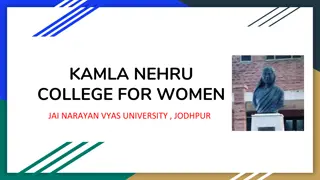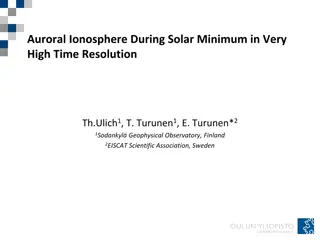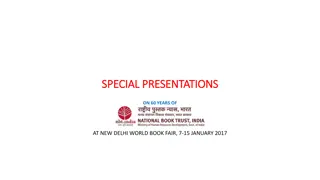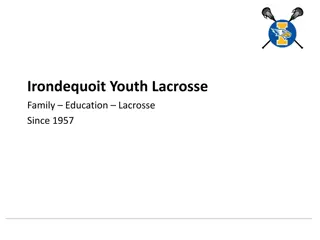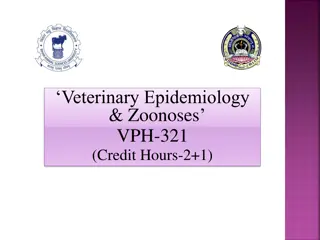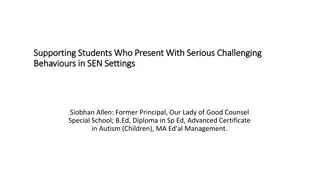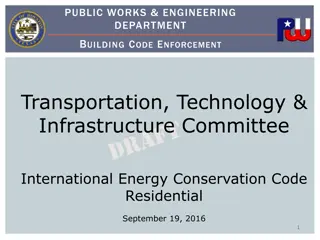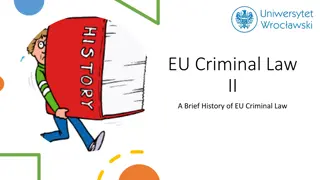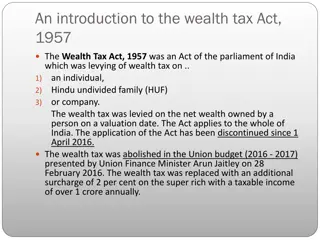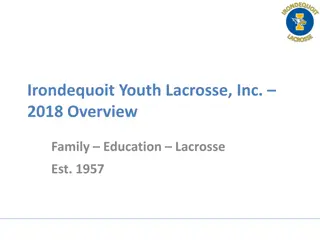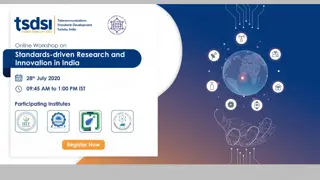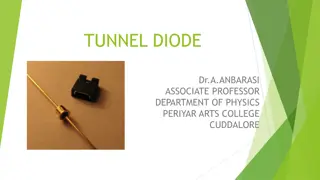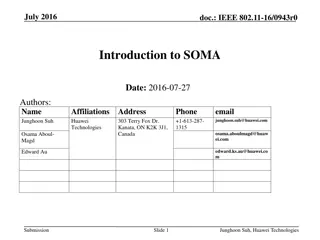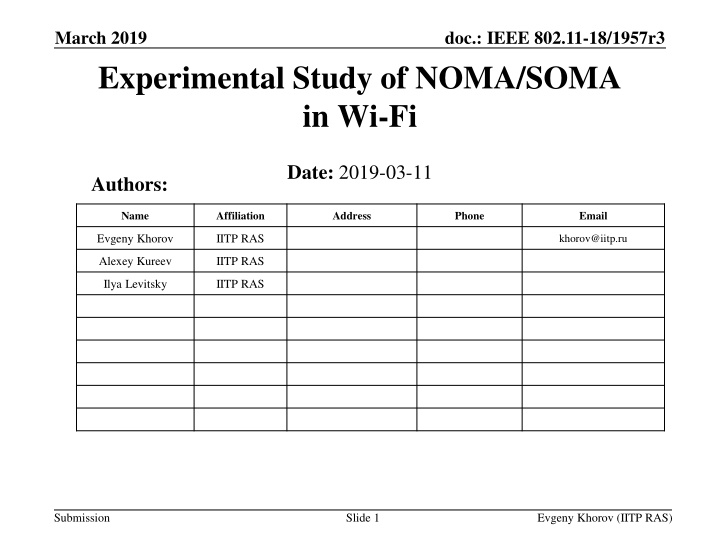
Experimental Study of NOMA/SOMA in Wi-Fi Networks
Explore the experimental study of Non-Orthogonal Multiple Access (NOMA) and Specific NOMA (SOMA) in Wi-Fi networks as a solution for serving devices at varying distances with different traffic loads. This presentation delves into theoretical concepts, testbed descriptions, and practical results for enhancing spectrum efficiency in downlink NOMA scenarios.
Download Presentation

Please find below an Image/Link to download the presentation.
The content on the website is provided AS IS for your information and personal use only. It may not be sold, licensed, or shared on other websites without obtaining consent from the author. If you encounter any issues during the download, it is possible that the publisher has removed the file from their server.
You are allowed to download the files provided on this website for personal or commercial use, subject to the condition that they are used lawfully. All files are the property of their respective owners.
The content on the website is provided AS IS for your information and personal use only. It may not be sold, licensed, or shared on other websites without obtaining consent from the author.
E N D
Presentation Transcript
March 2019 doc.: IEEE 802.11-18/1957r3 Experimental Study of NOMA/SOMA in Wi-Fi Date: 2019-03-11 Authors: Name Affiliation Address Phone Email Evgeny Khorov IITP RAS khorov@iitp.ru Alexey Kureev IITP RAS Ilya Levitsky IITP RAS Submission Slide 1 Evgeny Khorov (IITP RAS)
March 2019 doc.: IEEE 802.11-18/1957r3 Outline Motivation NOMA and SOMA brief introduction KPIs Theoretical results Testbed description November 18 results for NOMA (and short links) February 19 results for SOMA (and long links) Submission Slide 2 Evgeny Khorov (IITP RAS)
March 2019 doc.: IEEE 802.11-18/1957r3 Motivation In current networks, it is a typical situation when an AP serves several devices located at different distances from the AP (thus having different channel attenuation) having different traffic load. In this case, Non-orthogonal multiple access (NOMA) can be a promising solution to increase spectrum efficiency. This presentation considers theoretical and experimental results for DOWNLINK NOMA. [1] proposes SOMA, which is actually a specific case of NOMA (having no SIC). [1] doc.: IEEE 802.11-18/1462r0 SOMA for EHT Submission Slide 3 Evgeny Khorov (IITP RAS)
March 2019 doc.: IEEE 802.11-18/1957r3 Basic Idea of Downlink NOMA Power Traditional TDMA Different MCSs NOMA Power P P To STA2 To STA2 ? ? To STA1 To STA1 STA 2 AP STA 1 ????2= ? log 1 +(1 ?) ? ??? ????2 ? ?????2 STA2 decodes signal to STA1 and performs Successive Interference Cancelation (SIC) ? ? ??? ????1 ????1= ? log 1 + ? (?????1+ (? ?) ? ?????????) Submission Slide 4 Evgeny Khorov (IITP RAS)
March 2019 doc.: IEEE 802.11-18/1957r3 Signal Superposition TX side RX side STA1 Q I STA2 Submission Slide 5 Evgeny Khorov (IITP RAS)
March 2019 doc.: IEEE 802.11-18/1957r3 A possible transmission process SIFS SIFS DIFS To STA2 To STA1 AP STA1 ACK STA2 ACK Submission Slide 6 Evgeny Khorov (IITP RAS)
March 2019 doc.: IEEE 802.11-18/1957r3 KPI Average throughput Can be increased if we block the client with the worst channel conditions Geometric Mean Throughput KPI, widely used in cellular networks optimization as the target utility function: log(? ???) Equals zero, if any client is blocked Reaches the maximum value, if all the clients share the channel fairly (the same portion of channel time) This is called proportional fair resource allocation In a scenario with N client (saturated/full buffer/ traffic), each client obtains throughput ? is alone. Slide 7 ?, where T is the maximal throughput if the client Submission Evgeny Khorov (IITP RAS)
March 2019 doc.: IEEE 802.11-18/1957r3 With SOMA, no SIC is needed AP STA 2 STA 1 Q STA 2 0001 0011 1011 1001 Gray-mapped superposed constellation STA 1 0000 0010 1010 1000 I Q Q Q 1110 0100 1100 0110 I I I 1111 0101 1101 0111 BPSK Result QPSK Can be considered as multiplexing + reflection of constellations Submission 8 Evgeny Khorov (IITP RAS)
March 2019 doc.: IEEE 802.11-18/1957r3 Theoretical Results for 11a 802.11a PHY SNR1 3 dB SNR2 19 dB MCS TDMA 0 and 6 MCS NOMA 0 and 4 ? 0.85 Payload 1K/4K to align NOMA payloads Comments 1)Round Robin 1K/1K Equal throughput for both STAs 2)Round Robin 1K/4K Throughput for STA1 goes down, Throughput for STA2 is 4 times higher than for STA1 3)Proportional fair 1K/4K Equal channel time. Thrp for STA1 even lower, Thrp for STA 2 even higher -> Max Geomeric Mean Thrp 4)NOMA 1K/4K 92% gain in thrp for STA1, small gain in thrp for STA2, Overall gain +43% Submission Slide 9 Evgeny Khorov (IITP RAS)
March 2019 doc.: IEEE 802.11-18/1957r3 Trade-off between throughputs for STA1 & STA2 max average/total thrp is not a good target ???? (????) ???? Proportional fair operation point ???? ???? ?=0.85 Mix of NOMA (STA1 and STA2) and CSMA (STA2) Round Robin Operation point Submission Slide 10 Evgeny Khorov (IITP RAS)
March 2019 doc.: IEEE 802.11-18/1957r3 Testbed AP (SDR) Can be used with legacy off-the-shelf device! STA2(SDR) As NOMA device Full description: E. Khorov, A. Kureev, I. Levitsky. NOMA Testbed on Wi-Fi. //In Proc. of IEEE PIMRC, Bologna, Italy, 9-12 September 2018 STA1(Laptop) legacy device Submission Slide 11 Evgeny Khorov (IITP RAS)
March 2019 doc.: IEEE 802.11-18/1957r3 TX Implementation TX IQ Processing Data 1 Data bytes to bits ? Encoder Modulator Source to RF FFT Data 2 Data bytes to bits ? ? Encoder Modulator +reflection Submission Slide 12 Evgeny Khorov (IITP RAS)
March 2019 doc.: IEEE 802.11-18/1957r3 RX Implementation Demodulator & Decoder Bits to data bytes Data 1 Decoder Demodulator Destination ? ?=? ? RX IQ Processing from RF ? Bits to data bytes Data 2 Decoder Demodulaor weak signal is isolated here weak signal is isolated here Always trying to separate SOMA packets If no SOMA, the following check fails: Reserved bit, tail bits, parity bits, N_SYM1 N_SYM2 (NO additional SOMA indication bits used!) (NO additional SOMA indication bits used!) Submission Slide 13 Evgeny Khorov (IITP RAS)
March 2019 doc.: IEEE 802.11-18/1957r3 Implementation PHY RX State machine PHY RX State machine for weak signal for weak signal False Signal detected Done Reserved bit, tail bits, parity check passed & N_SYM1 N_SYM2 L-SIG decoding IDLE ? ?= extracted ? ? ? True False Done True Frame decoding FCS check passed Frame received Submission Slide 14 Evgeny Khorov (IITP RAS)
March 2019 doc.: IEEE 802.11-18/1957r3 Minimal set of changes to the standard Capabilities IE Indicator that a device is able to decode a NOMA/SOMA frame the other of NOMA/SOMA (optional) The way how modulations are multiplexed For example, Gray-mapped superposed constellation Submission Slide 15 Evgeny Khorov (IITP RAS)
March 2019 doc.: IEEE 802.11-18/1957r3 NOVEMBER RESULTS Submission Slide 16 Evgeny Khorov (IITP RAS)
March 2019 doc.: IEEE 802.11-18/1957r3 Testbed. Experimental Setup AP (SDR) A legacy device is replaced with SDR to simplify gathering statistics STA2(SDR) As NOMA device In November experiments, we located devices in the same room, reduced TX power and used 30dB attenuators to model different channel conditions STA1(SDR) As legacy device Submission Slide 17 Evgeny Khorov (IITP RAS)
March 2019 doc.: IEEE 802.11-18/1957r3 Evaluation. Reference Throughputs STA1 Payload ~ 1kB STA2 Payload ~ 2kB Different payloads are needed to make multiplexed frames of the same duration Submission Slide 18 Evgeny Khorov (IITP RAS)
March 2019 doc.: IEEE 802.11-18/1957r3 Testbed. Results NOMA Link1 MCS1 Link2 MCS3 STA1 Payload ~ 1kB STA2 Payload ~ 2kB x1.5 Obtained as the average throughput of STA 1 and STA2, when each of them has 50% of channel time Submission Slide 19 Evgeny Khorov (IITP RAS)
March 2019 doc.: IEEE 802.11-18/1957r3 Balance between throughput for STA1 & STA2 ???? (????) ???? ???? ???? ?=0.86 Mix of NOMA (STA1 and STA2) and CSMA (STA2) Submission Slide 20 Evgeny Khorov (IITP RAS)
doc.: IEEE 802.11-18/1957r3 March 2019 FEBRUARY RESULTS (SOMA) Submission Slide 21 Evgeny Khorov (IITP RAS)
March 2019 doc.: IEEE 802.11-18/1957r3 Testbed. Experimental Setup AP (SDR) STA2(SDR) As NOMA device STA1(SDR) As legacy device In February experiments, we located devices in separate rooms to provide different channel conditions for STA1 and STA2. Submission Slide 22 Evgeny Khorov (IITP RAS)
March 2019 doc.: IEEE 802.11-18/1957r3 Location of devices (AP) STA1 Now, the devices are located in different rooms and no attenuators are used STA2 Submission Slide 23 Evgeny Khorov (IITP RAS)
March 2019 doc.: IEEE 802.11-18/1957r3 Example of stats Submission Slide 24 Evgeny Khorov (IITP RAS)
March 2019 doc.: IEEE 802.11-18/1957r3 Testbed Results PF Link1 MCS1 Link2 MCS5 SOMA Link1 MCS1 Link2 MCS3 Twice lower because of fair sharing x1.4 Submission Slide 25 Evgeny Khorov (IITP RAS)
March 2019 doc.: IEEE 802.11-18/1957r3 NOMA/SOMA Properties Backward compatibility (STA 1 can be legacy) Even if not standardized, any vendor can use NOMA/SOMA for transmission between its own devices, and at the same time transmit data to other devices. 1. Almost double throughput for the STA with poor channel (in case of fare resource allocation) OR 2. Manifold gain in throughput of the nearest STA (STA 2) while providing guaranteed throughput for the far STA (STA 1) 3. If devices are close to each other higher modulations are possible. Submission Slide 26 Evgeny Khorov (IITP RAS)
March 2019 doc.: IEEE 802.11-18/1957r3 Straw Poll Should NOMA/SOMA be considered as a possible solution for future 802.11 standards? Yes, for EHT Yes, for another project No Need more info Abstain Submission Slide 27 Evgeny Khorov (IITP RAS)

![❤[READ]❤ Robotic Exploration of the Solar System: Part I: The Golden Age 1957-19](/thumb/21623/read-robotic-exploration-of-the-solar-system-part-i-the-golden-age-1957-19.jpg)
